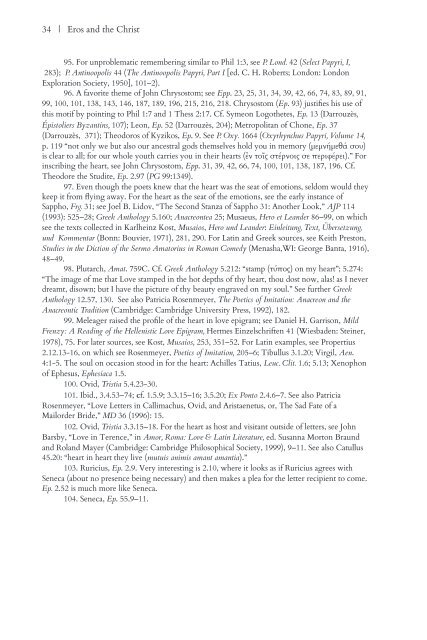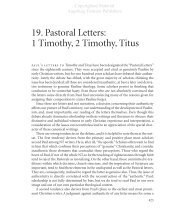Chapter 1 - Augsburg Fortress
Chapter 1 - Augsburg Fortress
Chapter 1 - Augsburg Fortress
Create successful ePaper yourself
Turn your PDF publications into a flip-book with our unique Google optimized e-Paper software.
34 | Eros and the Christ<br />
95. For unproblematic remembering similar to Phil 1:3, see P. Lond. 42 (Select Papyri, I,<br />
283); P. Antinoopolis 44 (The Antinoopolis Papyri, Part I [ed. C. H. Roberts; London: London<br />
Exploration Society, 1950], 101–2).<br />
96. A favorite theme of John Chrysostom; see Epp. 23, 25, 31, 34, 39, 42, 66, 74, 83, 89, 91,<br />
99, 100, 101, 138, 143, 146, 187, 189, 196, 215, 216, 218. Chrysostom (Ep. 93) justifies his use of<br />
this motif by pointing to Phil 1:7 and 1 Thess 2:17. Cf. Symeon Logothetes, Ep. 13 (Darrouzès,<br />
Épistoliers Byzantins, 107); Leon, Ep. 52 (Darrouzès, 204); Metropolitan of Chone, Ep. 37<br />
(Darrouzès, 371); Theodoros of Kyzikos, Ep. 9. See P. Oxy. 1664 (Oxyrhynchus Papyri, Volume 14,<br />
p. 119 “not only we but also our ancestral gods themselves hold you in memory (μεμνήμεθά σου)<br />
is clear to all; for our whole youth carries you in their hearts (ἐν τοῖς στέρνοις σε περιφέρει).” For<br />
inscribing the heart, see John Chrysostom, Epp. 31, 39, 42, 66, 74, 100, 101, 138, 187, 196. Cf.<br />
Theodore the Studite, Ep. 2.97 (PG 99:1349).<br />
97. Even though the poets knew that the heart was the seat of emotions, seldom would they<br />
keep it from flying away. For the heart as the seat of the emotions, see the early instance of<br />
Sappho, Frg. 31; see Joel B. Lidov, “The Second Stanza of Sappho 31: Another Look,” AJP 114<br />
(1993): 525–28; Greek Anthology 5.160; Anacreontea 25; Musaeus, Hero et Leander 86–99, on which<br />
see the texts collected in Karlheinz Kost, Musaios, Hero und Leander: Einleitung, Text, Übersetzung,<br />
und Kommentar (Bonn: Bouvier, 1971), 281, 290. For Latin and Greek sources, see Keith Preston,<br />
Studies in the Diction of the Sermo Amatorius in Roman Comedy (Menasha,WI: George Banta, 1916),<br />
48–49.<br />
98. Plutarch, Amat. 759C. Cf. Greek Anthology 5.212: “stamp (τύπος) on my heart”; 5.274:<br />
“The image of me that Love stamped in the hot depths of thy heart, thou dost now, alas! as I never<br />
dreamt, disown; but I have the picture of thy beauty engraved on my soul.” See further Greek<br />
Anthology 12.57, 130. See also Patricia Rosenmeyer, The Poetics of Imitation: Anacreon and the<br />
Anacreontic Tradition (Cambridge: Cambridge University Press, 1992), 182.<br />
99. Meleager raised the profile of the heart in love epigram; see Daniel H. Garrison, Mild<br />
Frenzy: A Reading of the Hellenistic Love Epigram, Hermes Einzelschriften 41 (Wiesbaden: Steiner,<br />
1978), 75. For later sources, see Kost, Musaios, 253, 351–52. For Latin examples, see Propertius<br />
2.12.13-16, on which see Rosenmeyer, Poetics of Imitation, 205–6; Tibullus 3.1.20; Virgil, Aen.<br />
4:1-5. The soul on occasion stood in for the heart: Achilles Tatius, Leuc. Clit. 1.6; 5.13; Xenophon<br />
of Ephesus, Ephesiaca 1.5.<br />
100. Ovid, Tristia 5.4.23-30.<br />
101. Ibid., 3.4.53–74; cf. 1.5.9; 3.3.15–16; 3.5.20; Ex Ponto 2.4.6–7. See also Patricia<br />
Rosenmeyer, “Love Letters in Callimachus, Ovid, and Aristaenetus, or, The Sad Fate of a<br />
Mailorder Bride,” MD 36 (1996): 15.<br />
102. Ovid, Tristia 3.3.15–18. For the heart as host and visitant outside of letters, see John<br />
Barsby, “Love in Terence,” in Amor, Roma: Love & Latin Literature, ed. Susanna Morton Braund<br />
and Roland Mayer (Cambridge: Cambridge Philosophical Society, 1999), 9–11. See also Catullus<br />
45.20: “heart in heart they live (mutuis animis amant amantia).”<br />
103. Ruricius, Ep. 2.9. Very interesting is 2.10, where it looks as if Ruricius agrees with<br />
Seneca (about no presence being necessary) and then makes a plea for the letter recipient to come.<br />
Ep. 2.52 is much more like Seneca.<br />
104. Seneca, Ep. 55.9–11.




